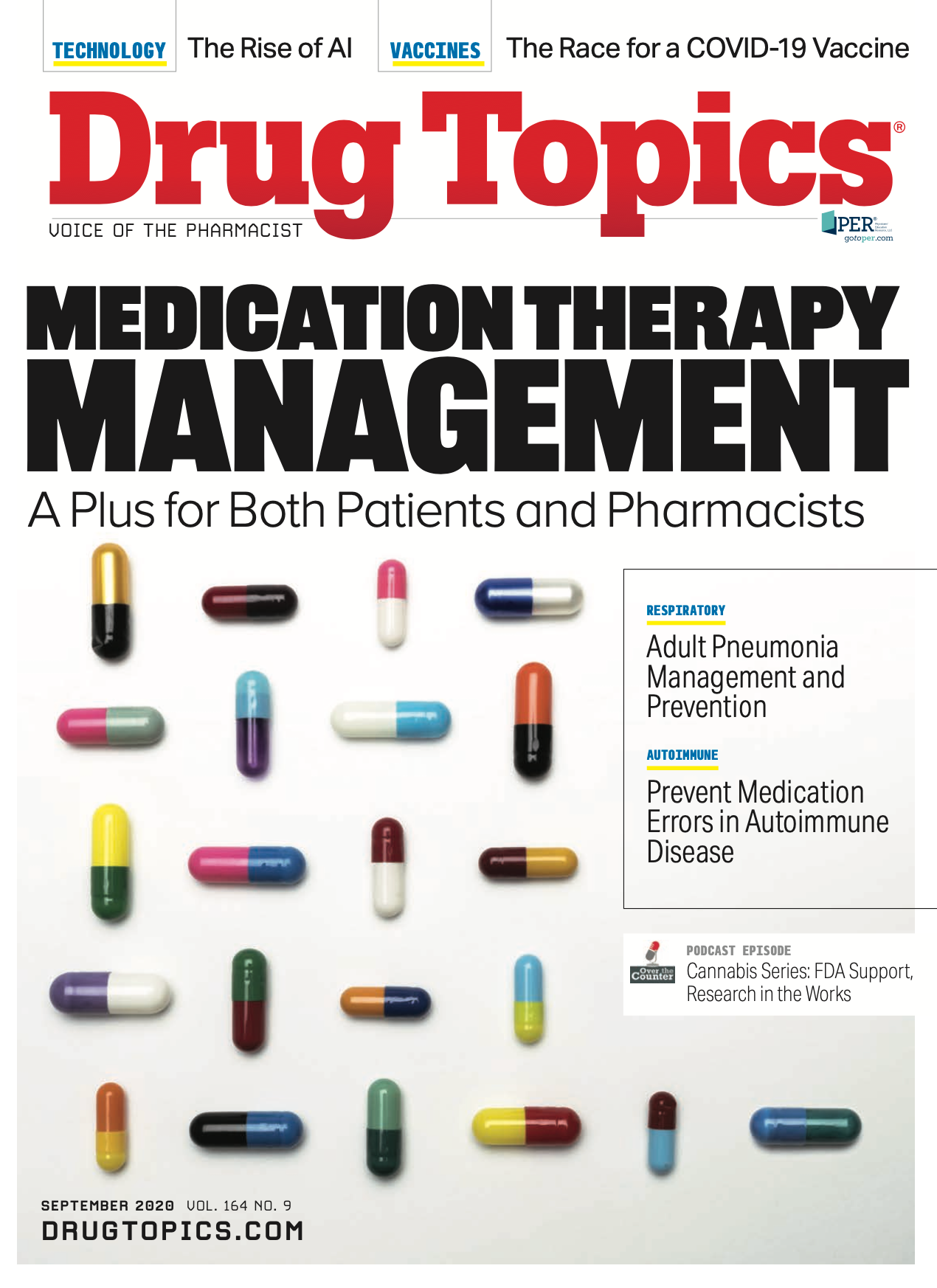Medication Therapy Management
A plus for both patients and pharmacists

One in 4 Americans used 3 or more prescription medications during the last 30 days.1 Such medications may have been prescribed by multiple specialists and filled at various pharmacies, combined with supplements or OTC medications, leading to potential adverse effects (AEs) or less than optimal results.2 Such mismanagement—or rather a lack of overall management—leads to 1.5 million preventable adverse events every year.2
That’s where medication therapy management (MTM) can help. By incorporating MTM into their practice, independent pharmacists can help patients prevent medication-related problems and optimize their medication use.
When patients are invited to an MTM session for a comprehensive medication review (CMR), they are asked to bring all their medications, including supplements and OTC products.
“Medication therapy management is a very broad term which includes interventions performed by pharmacists like medication reconciliation, medication synchronization, comprehensive medication reviews, therapeutic interchange, identifying drug therapy problems, immunization, and disease state education,” said Dimmy Sokhal, PharmD, chief clinical officer at Hayat Pharmacy. “While we offer comprehensive medication review, the pharmacist reviews the medications for the patients and reconciles the medication based on medication lists received from the patient’s prescribers to ensure accuracy.”
MTM has been shown to prevent AEs in patients, enhance medication use, and reduce hospitalizations. After assessing a patient’s total medication regimen, a pharmacist can provide the information to every member of a patient’s health care team. “Medication therapy management involves an assessment and evaluation of the patient’s complete medication therapy regimen, rather than focusing on an individ- ual medication product,” said Jessica Abraham, PharmD, APh, director of population health for the University of Southern California School of Pharmacy and director of the USC Medication Management Center.“MTM services optimize therapeutic outcomes and reduce the risk of adverse events through improved medication use.”
A Cost-Effective Business Opportunity
Providing this service is not only useful to patients and members of the health care team. It can be a good way for independent pharmacies to expand their business, as a variety of payers are prepared to cover the costs of such oversight.
“Since Medicare Part D payers are required to cover MTM services for eligible patients, this is an opportunity for pharmacies to provide a billable service and expand beyond solely dispensing functions, hence further building up their business,” Abraham said. Additionally, some adherence problems are simple to diagnose, and an MTM session can prevent serious problems, and reduce costs for both the patient and health care system over time.
Emlah Tubuo, PharmD, RPh, and owner of Powell Pharmacy, had one patient bring 6 bottles of metformin to an MTM session. When asked why she had so many bottles of her diabetes medication, the patient described her last doctor’s visit, where she was praised for her progress in controlling the disease. After 3 months of taking the medication, she assumed she was cured and had not taken any more of the treatment for 2 months.
“The doctor was encouraging her because she is on a positive path and she thought, I’ve treated my diabetes and I’m good to go,” said Tubuo.“Fortunately, we did CMR on that day and I told her, this is a journey, one step at a time. She had not asked the doctor whether she should stop taking
it. She just assumed. She would have gone back in 3 or 4 months to see the doctor and would have been back to where she started.”
Occasionally, a patient may have 2 prescriptions for the same condition with potentially dangerous consequences.
“We also see people who see multiple doctors for different things, and we start to see duplicates of medication—not even the same meds,” said Brianne L. Porter, PharmD, MS, assistant professor of clinical pharmacy, The Ohio State University, College of Pharmacy. “So, someone goes to a heart doctor and gets a drug for their heart, a β-blocker, and they are out of refills and the doctor is not responding. They might call their general practitioner and their general practitioner says, ‘I don’t want you to run out of it, I’ll refill it just for this month,’ and then the heart doctor restarts it. Then suddenly the patient is on the same kind of med from 2 different doctors, and they don’t know because they are not talking to each other.”
As well as making recommendations for medication safety and efficiency, during a review, a pharmacist might also suggest a vaccine. Patients with diabetes might be urged to get a flu vaccine, whereas patients over 50 years of age may be reminded about the shingles vaccine.
“We then send the recommendations to the physician, saying, we saw your patient and these are the things we discussed,” Tubuo said. “Here are our recommendations. Let us know what you think, print it out, sign it and send it back to us. If we have a patient with diabetes, we can ask if they want to add a statin. Sometimes we initiate it, sometimes they make a different decision, ‘no, not at this time.’ We work together as a team to take care of the patient. Don’t look at it as the pharmacist doing the doctor’s job. No one can do it all.”
Nonpharmacological options are also addressed. “You come in and you’re taking
a statin and chances are that you’re looking at what else you can do which will help your cholesterol and lower your chances of having a cardiovascular event,” said Tubuo. “As a pharmacist, we also focus on those non- pharmacological options, optimizing those medication outcomes, because if you look at the guidelines, they always say in addition to lifestyle and diet changes. We forget that. Those are hard. Those are where we need to hold each other’s hands.”
5 Core Elements of Medication Therapy Management
- Review and optimize medication therapy
- Examine the patient’s personal medication record
- Develop an action plan
- Make necessary interventions and/or referrals
- Document and follow up
Setting Up a Plan
A pharmacist can help set up a specific plan. “Once the medications are reviewed, pharmacists address barriers to compliance, review the patient’s pertinent vitals, lab values and set up clinical goals,” said Sokhal .“Pharmacists also review relevant lifestyle changes and set up SMART goals [specific, measurable, achievable, relevant, time-bound] for the patients. We utilize our dispensing software to document the interventions, action plan, and follow-up plan and also to submit pharmacist eCare plans.”
Vendor-supplied documentation platforms, such as Outcomes and SinfoniaRX, provide centralized information and can make documentation easier.
“When I pull you up, if you filled your prescription at any of the chains, I will see your prescription history for the past 12 months.” Tubuo said.
Many patients are not aware that the MTM service exists or that it is often free.
“Marketing MTM services is important so that members realize they have a service available to them that may improve their therapeutic outcomes while reducing the risk of adverse events,” said Abraham. “It’s also important to emphasize that MTM services are free and may save you money since pharmacists help optimize medication use with cost-effective drug choices.”
Getting Paid
There are several ways pharmacies can get paid for this service. “As a new pharmacy wanting to provide MTM services and get paid for it, I would definitely start looking at the American Pharmacists Association’s MTM Resources,” Abraham said. “There are some basic requirements which you probably already have as a pharmacy, such as obtaining a National Provider Identifier number. The easiest way is to consult with all of your contracted payers to determine how MTM services should be billed.”
In some cases, the payer uses its own employee pharmacists to provide MTM and does not contract for the services, but in other cases the payer contracts with pharmacies orindividual pharmacists to provide the services.
“We receive MTM-eligible members from the health plan and then basically provide outreach to them so that we can provide them with their MTM opportunities remotely at their convenience,” said Abraham.
Offering MTM During COVID-19
MTM sessions can serve a critical function during the coronavirus disease 2019 (COVID-19) pandemic, which has made it more difficult but even more important for vulnerable patients to manage chronic diseases such as diabetes, hypertension, heart failure, and asthma.
“Patients have decreased access to care and are scared to visit their doc- tors’ offices,” said Abraham. “Many of them have questions about their medications, uncontrolled chronic disease conditions, general health, and nowhere to go. Access to care has dramatically decreased in the COVID era, and the provision of MTM services provides patients increased access to care from their home at their convenience.”
The pandemic has resulted in more remote health care communication. To set up remote MTM meetings, on a basic level, pharmacists need a computer/laptop, phone, and documentation platform to provide MTM services. Technology resources such as Doximity, Microsoft Teams, Zoom, and Cisco Webex, have proven helpful.
Providing MTM services also opens opportunities for other clinical pharmacy services such as comprehensivemedication manage- ment (CMM) services, where pharmacists are able to provide chronic disease state management to patients in partner-ship with their health plan and primary care providers.
In Tubuo’s experience, when patients find out MTM is a free service, they almost always want to do it. “People feel rushed every time they are around a medical provider. If you go online and look for physician reviews, the best review is, ‘This doctor actually sat down and talked with me. I did not feel like he just wanted to hurry me out of the room.’ People want to be listened to. Typically when you come to the pharmacy, you pick up your prescription, you make a payment and walk out the door. People go home with so many questions.”
References:
- CDC. Therapeutic Drug Use. National Center for Health Statistics. Accessed July 23, 2020. Last reviewed April 13, 2020. https://www.cdc.gov/nchs/fastats/drug-use-therapeutic.htm
- American Pharmacists Association. Advancing the Value of MTM. Accessed July 23, 2020. https://portal.pharmacist.com/advancing-value-mtm#:~:text=Medication%2Drelated%20problems%20and%20medication,%24177%20billion%20in%20injury%20%26%20death..
